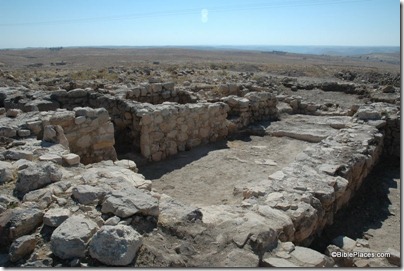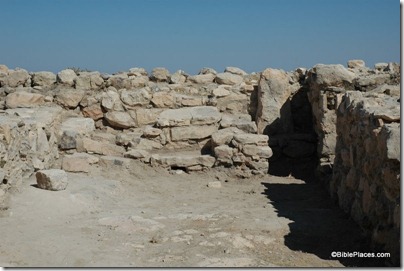It was just another roadside stop on my quest to find and photograph every biblical site known in the country of Jordan. While most tourists, even those biblically oriented, don’t visit much more than Petra, Jerash (Gerasa), and Mount Nebo, there are dozens of other sites in Jordan mentioned in the
Old Testament. I was at one of these when my traveling partner decided he had seen enough piles of rocks and was going to wait in the car.
This site, however, was more than a pile of rocks. Recent excavations had revealed some walls, floors, and a cave. As I made a circuit around the site, I had the distinct impression that I was looking at a temple. I cannot recall now all the features that led me to this conclusion, but by the time I returned to the car I was absolutely convinced that I had “discovered” a temple at biblical Ataroth (modern Attarus or Ataroz).
Some later research revealed that excavators from LaSierra University believed they were working on an Iron Age temple. The natural question for me was whether this was a Moabite temple or an Israelite temple. I was not privy to the details, and these could be ambiguous in any case (faithless Israelites do not look very different from their neighbors). Biblically we know that this area, the Medeba Plateau, shifted hands several times between the Israelites and their cousins. Perhaps you recall Jephthah’s declaration that this land belonged to Israel for 300 years (Judges 11:26). At the time he was contesting Ammonite control, but at other times it was the Moabites who were trying to expand into the land that Israel conquered under Moses (Numbers 21:21-35).
Yesterday news of the temple discovery was published by the Associated Press (HT: Joe Lauer). The story notes that about 300 vessels and deity figurines were uncovered, most in the last few months. It also attributes the temple to the Moabites. Such a designation does not surprise me for two reasons.
First, the Moabites probably controlled this area more than the Israelites did. Second, there are political reasons for not associating ancient Israelites with the country of Jordan. But if you’re thinking that the Israelites would never have a temple outside of Jerusalem, then you haven’t read your Bible very well. The Israelites had shrines all over the place. Even Solomon built a high place to the Moabite god for his Moabite wife (1 Kings 11:7).
The AP article has only two photos about the discovery, both showing artifacts. Below are two images of the temple itself, both taken six years ago. Apparently it was the recent discovery of the figurines that led to the press conference only now announcing the temple.


6 thoughts on “Temple Discovered in Ataroth, Jordan”
You mention the "shrines" the Israelites had on both sides of the Jordan during this period. Does the notion of shrines really imply full-blown "temples" such as the one pictured at Ataroth?
Or does the general notion of the Israelite's "adultery" and "whoring" after other gods simply mean incense-burning and praying at local high places near their towns? Did the Israelites, as a general practice, actually build large stone temples to the gods of Moab? … or were they in place already, the work of the goyim in their midst? Not saying Israelites never went in these places, but I am not convinced they were 'building' temples of this scale and complexity.
It is also important [I believe] when mentioning the involvement of the Israelites and even Solomon in the worship of these pagan gods as disobedience to YHWH! Sure, they were doing it alright; but, this very practice of idolatry, along with injustice toward the poor, widows and orphans, etc. is what brought down the Kingdoms of Israel and later, Judah and their subsequent exiles. The archaeology confirms the Bible. Love your blog, Todd, thanks for sharing.
Dani – I completely concur on your point about noting the reality that worship centers outside of Jerusalem were in defiance of God's law. Perhaps you're suggesting this should be stated more clearly because of a view among some scholars that such practices were only retroactively deemed illegal. Your point is well made.
As for shrines vs. temples, we don't have much archaeological evidence for either in the land and time of the Israelites. Probably in most cases the high places were rather primitive affairs that would not meet our definition of temples. But the structure at Arad certainly qualifies (and bears some resemblance to this one at Ataroth). The horned altar at Beersheba testifies to the presence of a temple there as well. Based on Amos 5:5, I might guess that there was also an illicit temple at Gilgal. Of course, in the northern kingdom we have the temple at Dan. The temple at Bethel has not been discovered and was probably thoroughly destroyed.
Who were these temples to? Were they built for the gods of other nations? Probably not in most cases. The ones mentioned by Solomon were probably more what we would classify as shrines. Israel seems to have been more attracted to syncretistic worship – a blending of Yahweh worship with other practices, though the time of Ahab with its thorough-going Baal worship is a notable exception.
One last thought – the Ataroth temple might be considered large and "complex" given what else is found today, but in light of the biblical description of Solomon's temple, it could well have been considered a shrine or high place.
Are you aware of any secondary literature that has been published regarding this temple?
Joseph – according to this interview with the excavator, he will only publish his findings this fall. I do recall finding some confirmation after my visit in 2004 that this was an Iron Age temple but I do not remember the source of that information.
The link to that interview is:
http://www.lasierra.edu/index.php?id=3506
Thanks Todd!